
The genus Fringilla is a small group of finches from the Old World, which are the only species in the subfamily Fringillinae.

The ruby-topaz hummingbird, commonly referred to simply as the ruby topaz, is a species of hummingbird in the subfamily Polytminae, the mangoes. It is found in Aruba, Bolivia, Bonaire, Brazil, Colombia, Curaçao, French Guiana, Guyana, Panama, Suriname, Trinidad and Tobago, and Venezuela.
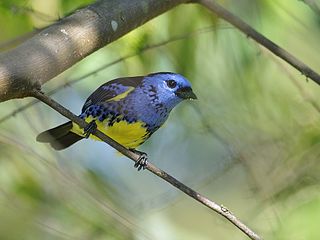
The turquoise tanager is a medium-sized passerine bird in the tanager family Thraupidae. It is a resident bird from Trinidad, much of Brazil, Colombia and Venezuela south to Bolivia. It is restricted to areas with humid forest, with its primary distribution being the Amazon. It was formerly treated as being conspecific with the white-bellied tanager which is found in the Atlantic Forest of eastern Brazil.
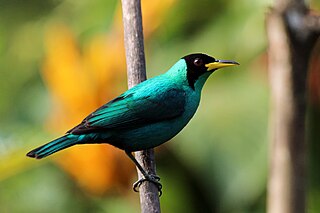
The green honeycreeper is a small bird in the tanager family. It is found in the tropical New World from southern Mexico south to Brazil, and on Trinidad. It is the only member of the genus Chlorophanes.

The purple honeycreeper is a small Neotropical bird in the tanager family Thraupidae. It is found in the tropical New World from Colombia and Venezuela south to Brazil, and on Trinidad. A few, possibly introduced birds have been recorded on Tobago.
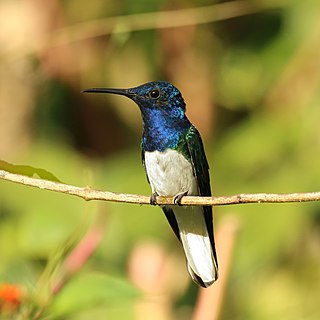
The white-necked jacobin is a medium-size hummingbird that ranges from Mexico south through Central America and northern South America into Brazil, Peru and Bolivia. It is also found in Trinidad & Tobago.

The bay-headed tanager is a medium-sized passerine bird. This tanager is a resident breeder in Costa Rica, Panama, South America south to Ecuador, Bolivia and north-western Brazil, and on Trinidad.

The yellow-rumped cacique is a passerine bird in the New World family Icteridae. It breeds in much of northern South America from Panama and Trinidad south to Peru, Bolivia and central Brazil. However, they have been sighted as far north as Nayarit state in Mexico.
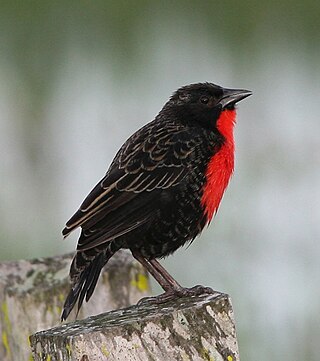
The red-breasted meadowlark is a passerine bird in the New World family Icteridae. It was formerly named red-breasted blackbird but is not closely related to the red-winged blackbird group.

The blue-tailed emerald is a hummingbird in the "emeralds", tribe Trochilini of subfamily Trochilinae. It is found in tropical and subtropical South America east of the Andes from Colombia east to the Guianas and Trinidad, and south to northern Bolivia and central Brazil.

The yellow-chinned spinetail is a passerine bird found in the tropical New World from Trinidad and Colombia south to Argentina and Uruguay. It is a member of the South American ovenbird family Furnariidae.

The black-faced grassquit is a small bird. It is recognized as a tanager closely related to Darwin's finches. It breeds in the West Indies except Cuba, on Tobago but not Trinidad, and along the northern coasts of Colombia and Venezuela.

The saffron finch is a tanager from South America that is common in open and semi-open areas in lowlands outside the Amazon Basin. They have a wide distribution in Colombia, northern Venezuela, western Ecuador, western Peru, eastern and southern Brazil, Bolivia, Paraguay, Uruguay, northern Argentina, and Trinidad and Tobago. It has also been introduced to Hawaii, Panama, Puerto Rico and elsewhere. Although commonly regarded as a canary, it is not related to the Atlantic canary. Formerly, it was placed in the Emberizidae but it is close to the seedeaters.
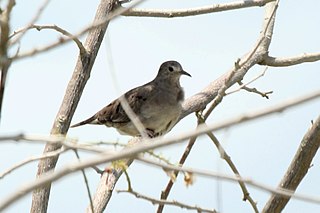
The plain-breasted ground dove is a species of bird in the family Columbidae. It lacks the scaled appearance to the feathers of the similar and typically more abundant common ground dove.

The golden-sided euphonia is a species of bird in the family Fringillidae. It is found in northern Brazil, French Guiana, Guyana, Suriname and eastern Venezuela. Its natural habitat is subtropical or tropical moist lowland forest.

The purple-throated euphonia is a songbird species in the family Fringillidae. It was formerly placed in the Thraupidae.

The bare-necked fruitcrow is a species of bird in the family Cotingidae. It is the only member of the genus Gymnoderus. It is found in the Amazon Rainforest, especially near rivers. It is relatively common, but generally rarer and more local north of the Amazon River. Both sexes are overall mainly blackish, but the male has distinctive, large greyish-blue facial- and neck-wattles and greyish-white wings, which flash conspicuously in flight.

The chestnut-bellied seed finch is a species of bird in the family Thraupidae, but was until recently placed in Emberizidae.

The coraya wren is a species of bird in the family Troglodytidae, the wrens.
In the 10th edition of Systema Naturae, published in 1758, the Swedish naturalist Carl Linnaeus described 554 species of bird and gave each a binomial name.






















